Related Research Articles
A soil type is a taxonomic unit in soil science. All soils that share a certain set of well-defined properties form a distinctive soil type. Soil type is a technical term of soil classification, the science that deals with the systematic categorization of soils. Every soil of the world belongs to a certain soil type. Soil type is an abstract term. In nature, you will not find soil types. You will find soils that belong to a certain soil type.

Aridisols are a soil order in USDA soil taxonomy. Aridisols form in an arid or semi-arid climate. Aridisols dominate the deserts and xeric shrublands, which occupy about one third of the Earth's land surface. Aridisols have a very low concentration of organic matter, reflecting the paucity of vegetative production on these dry soils. Water deficiency is the major defining characteristic of Aridisols. Also required is sufficient age to exhibit subsoil weathering and development. Limited leaching in aridisols often results in one or more subsurface soil horizons in which suspended or dissolved minerals have been deposited: silicate clays, sodium, calcium carbonate, gypsum or soluble salts. These subsoil horizons can also be cemented by carbonates, gypsum or silica. Accumulation of salts on the surface can result in salinization.
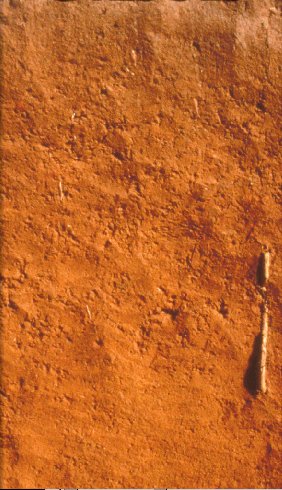
Oxisols are a soil order in USDA soil taxonomy, best known for their occurrence in tropical rain forest within 25 degrees north and south of the Equator. In the World Reference Base for Soil Resources (WRB), they belong mainly to the ferralsols, but some are plinthosols or nitisols. Some oxisols have been previously classified as laterite soils.

Mollisol is a soil type which has deep, high organic matter, nutrient-enriched surface soil, typically between 60 and 80 cm in depth. This fertile surface horizon, called a mollic epipedon, is the defining diagnostic feature of Mollisols. Mollic epipedons are created by long-term addition of organic materials derived from plant roots and typically have soft, granular soil structure.

Gelisols are an order in USDA soil taxonomy. They are soils of very cold climates which are defined as containing permafrost within two meters of the soil surface. The word "Gelisol" comes from the Latin gelare meaning "to freeze", a reference to the process of cryoturbation that occurs from the alternating thawing and freezing characteristic of Gelisols.
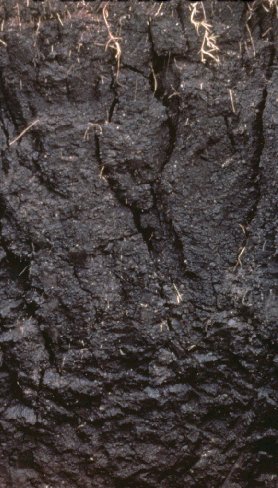
A vertisol, or vertosol, is a soil type in which there is a high content of expansive clay minerals, many of them known as montmorillonite, that form deep cracks in drier seasons or years. In a phenomenon known as argillipedoturbation, alternate shrinking and swelling causes self-ploughing, where the soil material consistently mixes itself, causing some vertisols to have an extremely deep A horizon and no B horizon.. This heaving of the underlying material to the surface often creates a microrelief known as gilgai.

In USDA soil taxonomy, Andisols are soils formed in volcanic ash and defined as soils containing high proportions of glass and amorphous colloidal materials, including allophane, imogolite and ferrihydrite. In the World Reference Base for Soil Resources (WRB), Andisols are known as Andosols.

Entisols are soils, as defined under USDA soil taxonomy, that do not show any profile development other than an A-horizon. Entisols have no diagnostic horizons, and are unaltered from their parent material, which could be unconsolidated sediment, or rock. Entisols are the most common soils, occupying about 16% of the global ice-free land area.
The World Reference Base for Soil Resources (WRB) is an international soil classification system for naming soils and creating legends for soil maps. The currently valid version is the fourth edition 2022. It is edited by a working group of the International Union of Soil Sciences (IUSS).

In soil classification, an Umbrisol is a soil with a dark topsoil and in which organic matter has accumulated within the mineral surface soil—in most cases with low base saturation—to the extent that it significantly affects the behaviour and utilization of the soil. Umbrisols are the counterpart of comparable soils with a high base saturation.
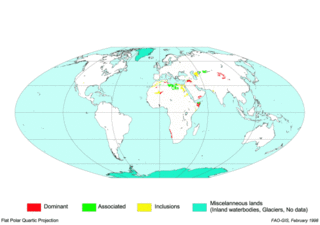
Gypsisols in the World Reference Base for Soil Resources (WRB) are soils with substantial secondary accumulation of gypsum (CaSO4.2H2O). They are found in the driest parts of the arid climate zone. In the USDA soil taxonomy they are classified as Gypsids (USDA Soil Taxonomy), in the Russian soil classification they are called Desert soils (USSR).

A gleysol is a wetland soil that unless drained is saturated with groundwater for long enough to develop a characteristic gleyic colour pattern. The pattern is essentially made up of reddish, brownish, or yellowish colours at surfaces of soil particles and/or in the upper soil horizons mixed with greyish/blueish colours inside the peds and/or deeper in the soil. Gleysols are also known as Gleyzems, meadow soils, Aqu-suborders of Entisols, Inceptisols and Mollisols, or as groundwater soils and hydro-morphic soils.

A petrocalcic horizon is a diagnostic horizon in the USDA soil taxonomy (ST) and in the World Reference Base for Soil Resources (WRB). They are formed when secondary Calcium Carbonate or other carbonates accumulate in the subsoil to the extent that the soil becomes cemented into a hardpan. Petrocalcic horizons are similar to a duripan and a petrogypsic horizon (WRB) in how they affect land-use limitations. They can occur in conjunction with duripans where the conditions are right and there are enough free carbonates in the soil. Calcium Carbonates are found in alkaline soils, which are typical of arid and semiarid climates. A common field test for the presence of carbonates is application of hydrochloric acid to the soil, which indicates by fizzing and bubbling the presence of calcium carbonates.
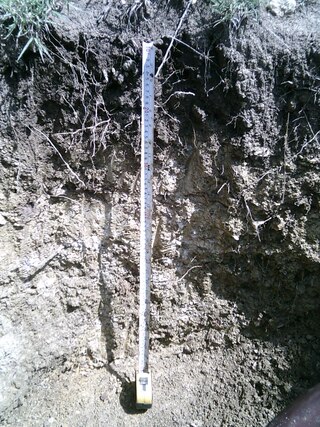
A Cambisol in the World Reference Base for Soil Resources (WRB) is a soil in the beginning of soil formation. The horizon differentiation is weak. This is evident from weak, mostly brownish discolouration and/or structure formation in the soil profile.

In the World Reference Base for Soil Resources (WRB), a Durisol is a soil of arid and semi-arid environments that contains cemented secondary silica (SiO2) in the upper metre of soil, either as concretions (durinodes – duric horizon) or als continuously cemented layer (duripan – hardpan (Australia) – dorbank (South Africa) – petroduric horizon). In the FAO/Unesco Soil Map of the World, the Durisols with petroduric horizon were indicated as duripan phase of other soils, e.g. of Xerosols and Yermosols.
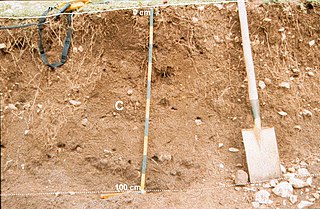
A Regosol in the World Reference Base for Soil Resources (WRB) is very weakly developed mineral soil in unconsolidated materials. Regosols are extensive in eroding lands, in particular in arid and semi-arid areas and in mountain regions. Internationally, Regosols correlate with soil taxa that are marked by incipient soil formation such as Entisols in the USDA soil taxonomy or Rudosols and possibly some Tenosols in the Australian Soil Classification.

A Planosol in the World Reference Base for Soil Resources is a soil with a light-coloured, coarse-textured, surface horizon that shows signs of periodic water stagnation and abruptly overlies a dense, slowly permeable subsoil with significantly more clay than the surface horizon. In the US Soil Classification of 1938 used the name Planosols, whereas its successor, the USDA soil taxonomy, includes most Planosols in the Great Groups Albaqualfs, Albaquults and Argialbolls.
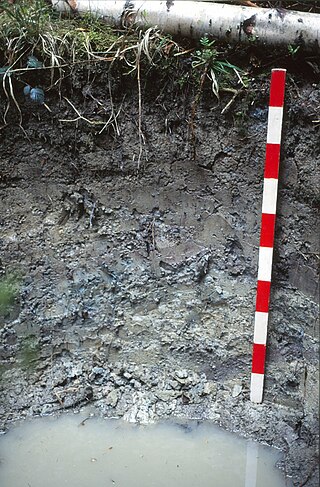
A Stagnosol in the World Reference Base for Soil Resources (WRB) is soil with strong mottling of the soil profile due to redox processes caused by stagnating surface water.

Andosols are soils found in volcanic areas formed in volcanic tephra. In some cases Andosols can also be found outside active volcanic areas. Andosols cover an estimated 1–2% of earth's ice-free land surface. Andosols are a Reference Soil Group of the World Reference Base for Soil Resources (WRB). They are closely related to other types of soils such as Vitrosols, Vitrandosols, Vitrons and Pumice Soils that are used in different soil classification systems. Poorly developed Andosols are often rich in vitreous materials and are therefore also called Vitric Andosols. The name comes from Japanese an and do, synonymous with kuroboku. In the USDA soil taxonomy, Andosols are known as Andisols.

A nitisol in the World Reference Base for Soil Resources (WRB) is a deep, red, well-drained soil with a clay content of more than 30% and a blocky structure. Nitisols correlate with the kandic alfisols, ultisols and inceptisols of the USDA soil taxonomy.
References
- ↑ Unit 10: Terms (Psamment) Archived 2009-04-10 at the Wayback Machine at pals.iastate.edu
- Soil Survey Staff: Keys to Soil Taxonomy. 12th edition. Natural Resources Conservation Service. U.S. Department of Agriculture. Washington D.C., USA, 2014.
- IUSS Working Group WRB: World Reference Base for Soil Resources, fourth edition. International Union of Soil Sciences, Vienna 2022. ISBN 979-8-9862451-1-9 ().